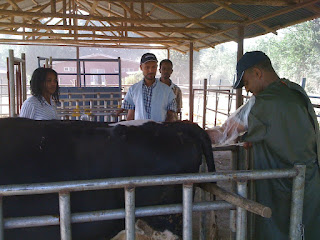Embryo Recovery at Debre Zeyit and Holeta
This morning Tadesa dropped me off at Debre Zeyit Agricultural Research Center to continue with the embryo work, and then headed out to take Haven, Mark and Abera around Addis to learn more about the meat industry there. When I arrived, I was ecstatic to see that Dr. Tamrat was already there, set up and ready to go.
I let Dr. Tamrat do the actual embryo retrieval and transfer this time. He flushed the first uterine horn without too much difficulty other than it took him a long time to get the catheter in and set, which is very fatiguing on the arm. (See picture below of Dr. Tamrat at work.) I was excited that he was willing and able to do it himself, with his assistants helping him.
Girma, the dairy manager at Genesis Farms, joined us and was intrigued by the ET concept. He was interested in speaking with his boss to see if they could do it at Genesis Farm. Dr. Tamrat took the filter in to do the searching, but unfortunately we didn't find any embryos. We set up the ultrasound and showed Girma what ovaries look like. We discovered that the cow that we flushed had several unovulated follicles similar to the cow at ATARC. I suggested that we use GNRH next time to help the ovulation. Dr. Tamrat also said that he had palpated the ovaries when he bred the cows, which could be part of the problem. I told him to stay away from the ovaries when breeding cows.
[After returning to the U.S., I consulted with bovine embryo transfer experts Jared McNaughton and Dr. Roy Silcox, and I have determined that the palpation of the ovaries at the time of breeding was probably the leading cause of our problems with recovery.]
We next drove to Holeta where we retrieved (flushed) embryos from two cows. One of the donors did not respond, but the other two responded very well. We recovered and transferred seven good embryos, four were from Kekeni, their prize cow. I was pleased that they found four of the seven embryos on their own. The crew from Debre Zeyit drove over to help, so they were able to see the entire process. It was dark when we went out to implant the embryos, so we used the car headlights to see. They were all so excited for the success. I was glad to be part of today's work. The results weren't as good as we would have expected in the U.S., but considering the circumstances, it went very well, and the training overall was excellent, so I am very happy with how everything went.

Comments
Post a Comment